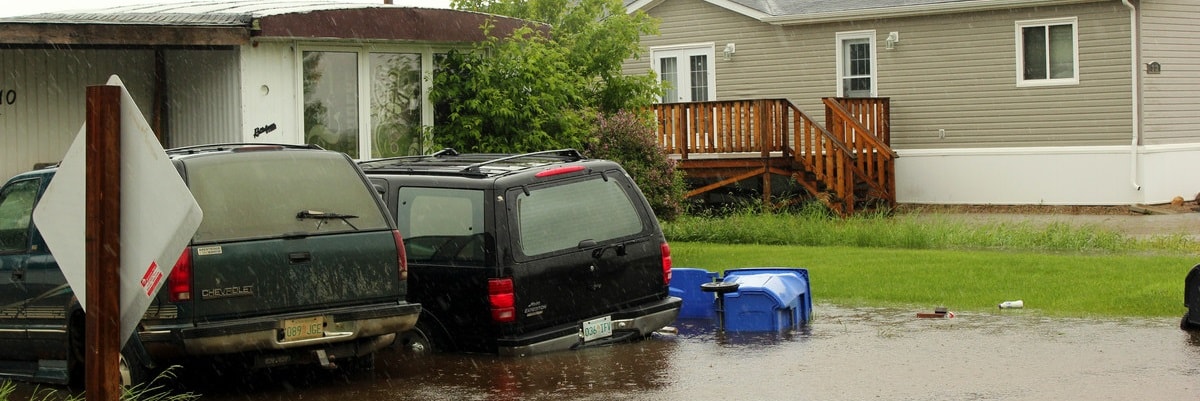Floods: Before, During & After

Floods can happen anywhere and at any time of the year. The best way to protect yourself and your family in case of a flood is to follow these steps:
- Monitor local weather and alerts: Know your risk.
- Turn around, don’t drown – avoid flood waters.
- Clean up carefully and wear protective clothing.
Before
- The key to staying safe is to prepare and to have an emergency plan in place.
- Know the flood risk in your community by calling your municipality and insurance company.
- Make sure your home insurance cover these flood risks: Fact sheet: Flood insurance fundamentals.
- Know and practice evacuation routes.
- Monitor local weather and alerts and follow instructions if told to evacuate.
- Have an emergency kit.
Actions to Take:
You can be ready to help protect yourself and your family from flooding.
Download this guide with steps you can take today.
- Obtain home insurance with flood coverage.
- Talk to your insurance provider about your risk and additional steps you can take to protect your home.
- Protect your valuables in waterproof containers. Place them above potential water levels.
- Put sealant around basement windows and the base of ground-level doors. Add window wells and covers to windows that are near or below ground level.
- Raise large appliances in the basement above the potential water level from a flood.
- Find your floor drain and make sure nothing is covering it like boxes, furniture or carpet.
- Install a sump pump, backup pump and power supply. Ensure all are in working order and test them regularly.
- Install a backwater valve. Keep it in working order.
- Check that your roof and eavestroughs are draining properly in heavy rains and that downspouts are directed well away from your home.
- Clean leaves, garbage, ice and other debris away from the storm drains near your home.
- Ensure your landscaping is properly sloped away from your home.
- Talk with your family and neighbours about what you would do during a flood.
- Have practice drills with your family, so you know what to do and are prepared.
- Buy or make an emergency kit, and keep it stocked. Families should be prepared to be self-sustaining for at least three days.
- If you have already dipped into your emergency kit and food supply while staying at home, consider safely getting the supplies to replenish it following your local public health authorities’ guidelines for leaving your residence.
- During the COVID-19 pandemic also add hygiene items such as hand sanitizer and non-medical masks to your kit to keep your family safe during an evacuation.
During
- Listen to area radio and television stations and Weatheradio for possible flood warnings and reports of flooding in progress.
- Be prepared to evacuate at a moment’s notice.
- When a flood or flash flood warning is issued for your area, head for higher ground and stay there.
- Turn around – don’t drown! Avoid walking and driving through flooded waters. They could be deeper than you think.
- Keep children and pets away from flood water.
- Be especially cautious at night when it is harder to recognize flood danger.
After
Continue to take precautions and listen to and follow directions from local authorities.
- Be alert for further instructions from officials and community leaders - listen to the radio, watch your local news channels, and/or follow your local news outlet and/or emergency officials on social media.
- Do not return home until you are advised it is safe to do so.
- Contact your insurance company and let them know what happened. They will want to know a record of damage to your home and belongings and may request photos or video.
- Maintain good hygiene during flood cleanup by minimizing contact with floodwater or anything that may have come in contact with it.
- Wear protective clothing, including rubber boots or sturdy boots, safety glasses, hard hat, rubber gloves and a dust mask.
- Do not use water that could be contaminated.
- Discard any food items which may have been in contact with flood waters. When in doubt, throw it out!
- Do not use any appliances, heating, pressure, or sewage system until electrical components are dry and have been inspected by a qualified electrician.
- Check with local authorities or community leaders on how to properly dispose of damaged items from your home.
- Experiencing a disaster is challenging enough, but during the COVID-19 pandemic it can feel even more difficult. The Red Cross has many resources available to help you navigate these challenging times. You can also find mental and emotional wellbeing resources on the Public Health Agency of Canada, or any provincial/territorial health authority website.
After a Disaster
Recovering after a disaster can be overwhelming. Check out what resources the Red Cross has to offer.
Read more
Get an Emergency Kit
Getting or making a kit is the final step in being ready for any emergency. Find out what you need to put in it.
Read more
Coping with Crisis
Learn how to recover emotionally from a disaster or emergency.
Read more